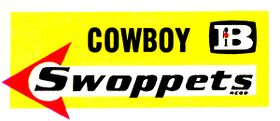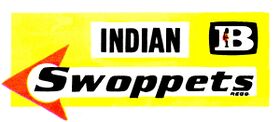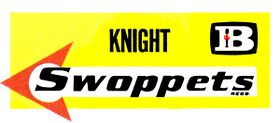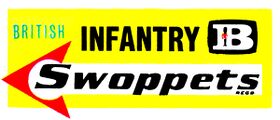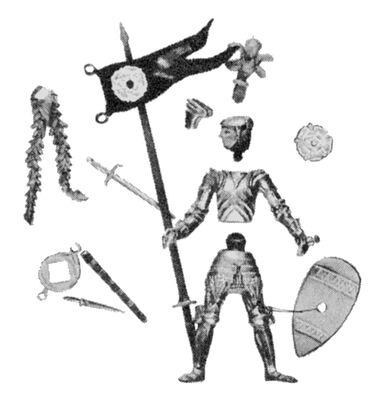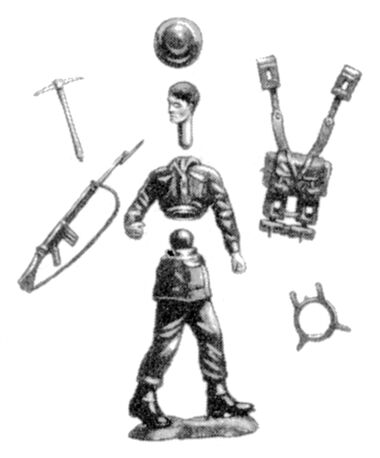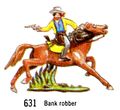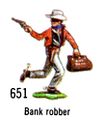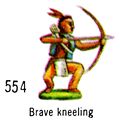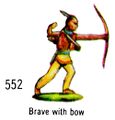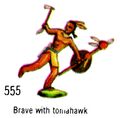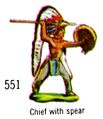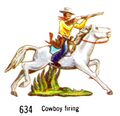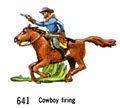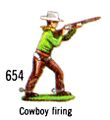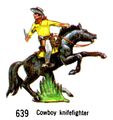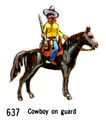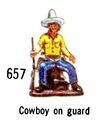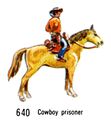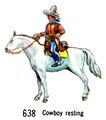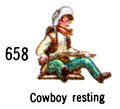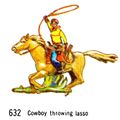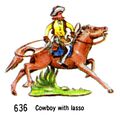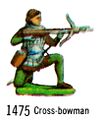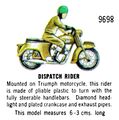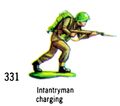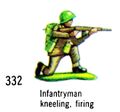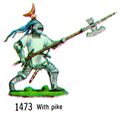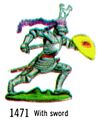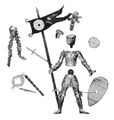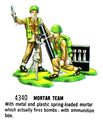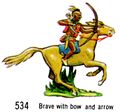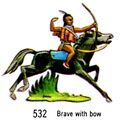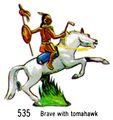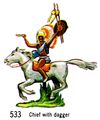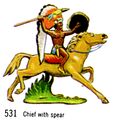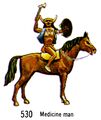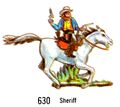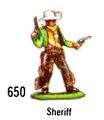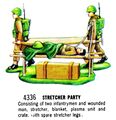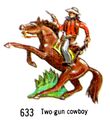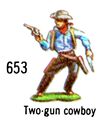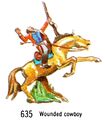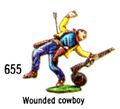Category:Swoppets
| Toy Brands and Manufacturers |
|---|
Swoppets |
| 1958 - |
Exploded view of a Swoppet Knight [image info]
Exploded view of a Swoppet British Infantryman [image info]
The Swoppets range of 1:32 plastic figures with interchangeable parts appeared in 1958, originally as a range of "cowboy" figures, which were later joined by a group of "indians" (i.e. Native Americans), and then Fifteenth Century Knights in armour, and British Infantry. Most of the figures were produced by Britains Ltd., and designed by Roy Selwyn-Smith, a highly-respected sculptor very experienced in designing for plastic who had been designing for Herald Miniatures until Britains took over the company.
According to James Opie's book on toy soldiers (2016), "... the Swoppets were without doubt the best looking movable part figures ever produced".
Britains and Herald
The very first 1958 Swoppets production was by Herald: with Britains Ltd. taking over the company, subsequent Swoppets production was "Britains"-branded, with the "Britains Herald" name being retained for the rest of the Herald plastic range that Britains continued to sell. Even though Swoppets had been designed by Roy Selywn Smith and put into production at Herald before Britains had finalised their takeover in 1959, Britains seem to have been very keen to emphasise that this had always been a Britains product.
SPECIAL NEW BOXED SETS
Now, the world famous "SWOPPET" models the original creation of Britains Ltd., are available in these handsome new style boxes. These vacuum formed inserts enable the models to be put away safely after use. Authentic models, these "Swoppet" cowboys and indians have interchangeable heads, bodies, scarves, gunbelts – even the guns can be removed from the holsters. Availabe in sets as illustrated below.
When is a Swoppet a Swoppet?
The subject of what is and what is not a Swoppet is surprisingly complicated.
For our purposes, we're treating the "full" Swoppets as being the Swoppet Cowboys, Swoppet Indians, and Swoppet Knights, and also the later British Infantry Swoppets. These all share the same two-part body with two fixed arms on an upper torso and two fixed legs on a lower torso, attached by the same large swivelling ball-and-socket waist joint, with s swivelling head.
However, the brandname seems to have been so effective that Britains ended up applying it semi-generically to things that weren't actually proper Swoppets, and had a different fundamental design that wasn't Swoppet-compatible. The catalogues in our archives (1960s) also list and index the posable plastic American Civil War figures as being Swoppets, but the accompanying pictures don't appear to show the brandname anywhere on the products' packaging, and the accompanying text slightly downplays the relationship, saying that the Civil War figures include "some" of the Swoppet features, in that they have moving heads and arms, and allow hats and rifles to be exchanged. This isn't quite the same as the Swoppets concept of figures that try to have pretty much everything swoppable.
The difficulty in extending the Swoppets concept to other "combat" groups was that in modern armies, there wasn't so much to swop. While Cowboys could have different hats and different coloured neckerchiefs, and different clothing that could be changed by swapping around torso and leg combinations, it was more difficult to produce new hybrid characters by swapping parts on soldiers who were all wearing the same standardised uniforms, all in the same colour.
Some collectors apparently also refer to the contemporary "Eyes Right" range of plastic British regimental figures as Swoppets, but this grouping seems to be based on based on date range and styling rather than on any attempt at swoppability. It's also possible that Britains may have later retrospectively referred to other ranges as Swoppets, but for these pages we're steadfastly ignoring this possibility and sticking to the 1960s catalogues.
Accessories
To further complicate classification, we also have the large (and nice) accessories that were made to accompany Swoppets figures ... the Concord Overland Stage Coach for the cowboys and indians, and the Siege Engines for the Swoppet Knights, which, while they were shown on the same catalogue pages and were obviously meant to "go" with Swoppets, weren't actually Swoppets themselves (in that they weren't meant to come apart and reassemble into other versions with different parts).
1967 catalogue text:
SWOPPET COWBOYS AND INDIANS
Perfect partners for a Wild West layout – these "swop and swivel" models feature interchangeable parts and are the original creation of BRITAINS LIMITED. Heads, bodies, scarves, gunbelts, etc., are detachable and interchangeable. Even the miniature guns, accurate replicas of the Colt 45 revolver, can be removed form their holsters. These exciting hand painted models are available singly or in the handsome presentation window cartons illustrated.
SWOPPET KNIGHTS
Here's perfection in miniature. Magnificent models of Fifteenth Century Knights to relive the Wars of the Roses. Made in the Swoppet tradition, all parts fitting firmly, yet easily detached. Lifting visors, removable swords, swivelling bodies, all brightly coloured and adorned with their heraldic devices. Available singly or in the handsome window cartons illustrated.
Missed opportunities
It might have been interesting, given the 1960s/1970s craze for kits and figures of "freaks" and monsters, if Britains had produced a Monster Swoppet range, or produced animals with interchangeable heads and parts, but perhaps that idea might have offended the aesthetics of the "purist" Britains designers, who were essentially producing highly artistic classical sculptures in miniature that strove for historical accuracy, and might not have liked the idea of corrupting their range with models of "made up" creatures.
Britains therefore missed on the craze associated with the Aurora Monster kits (starting with Frankenstein in 1962, obvious Swoppet material), which continued to be fuelled by the The Addams Family (1964-1966) and The Munsters (1964-1966), and which showed up in American plastic kitmakers "freak" models (like those produced by Hawk) inspired by 1960s counterculture cartoons.
Britains could have had a popular range of generic monsters with swappable parts, and then added robots to the range, so that one could have a gorilla with robot arms and a dinosaur legs, or a spaceship with arms and a robot head. They could have ridden the wave of Japanese Manga monsters, coasted through the Dungeons and Dragons and Fantasy genres and even benefited indirectly from the later 1980s "Transformers" craze for vehicles-that-turned-into-robots. But they didn't.
In the end, the public's desire for plastic figures that let one pick-and-mix body parts ended up having to wait for Lego's more abstract and highly successful Minifigures range, which first properly appeared in 1978.
External links
- Britains Swoppet Knights: History. The Story of Herald, Britains and the Swoppet Knights. (goldkeep.co.uk)
- Britains Swoppets Archive (britains-toy-soldiers.com)
- Britains Swoppets Knights (swoppets.net)
- Britains Swoppet 15th Century Knights (collections.vam.ac.uk)
- James Opie, Britains Toy Soldiers: The History and Handbook 1893-2013 (Pen and Sword, 2016) ISBN 1473885159
video:
- British Pathé: Brighton Toy Fair (1958) (youtube.com) –demonstration of the Britains Swoppets figures, with animated display
Subcategories
This category has the following 4 subcategories, out of 4 total.
C
- Swoppet Cowboys (31 F)
I
- Swoppet Indians (18 F)
- Swoppet Infantry (11 F)
K
- Swoppet Knights (17 F)
Media in category ‘Swoppets’
The following 76 files are in this category, out of 76 total.
- Bank Robber, Britains Swoppets 631 (Britains 1967).jpg 1,419 × 1,305; 662 KB
- Bank Robber, Britains Swoppets 651 (Britains 1967).jpg 833 × 989; 235 KB
- Brave Kneeling, Britains Swoppets 554 (Britains 1967).jpg 860 × 860; 218 KB
- Brave with Bow, Britains Swoppets 552 (Britains 1967).jpg 996 × 1,043; 242 KB
- Brave with Tomahawk, Britains Swoppets 555 (Britains 1967).jpg 1,082 × 1,066; 281 KB
- British Infantry Swoppets, logo (Britains 1967).jpg 1,200 × 513; 231 KB
- Chief with Dagger, Britains Swoppets 553 (Britains 1967).jpg 796 × 1,315; 329 KB
- Chief with Spear, Britains Swoppets 551 (Britains 1967).jpg 947 × 1,098; 346 KB
- Cowboy and Indian Box Set, Britains Swoppets 7630 (Britains 1967).jpg 1,200 × 953; 824 KB
- Cowboy Firing From Cover, Britains Swoppets 661 (Britains 1967).jpg 1,071 × 847; 297 KB
- Cowboy Firing, Britains Swoppets 634 (Britains 1967).jpg 1,386 × 1,340; 637 KB
- Cowboy Firing, Britains Swoppets 641 (Britains 1967).jpg 1,436 × 1,289; 548 KB
- Cowboy Firing, Britains Swoppets 654 (Britains 1967).jpg 893 × 976; 216 KB
- Cowboy Gunslinger, Britains Swoppets 656 (Britains 1967).jpg 815 × 1,065; 239 KB
- Cowboy Knifefighter, Britains Swoppets 639 (Britains 1967).jpg 1,351 × 1,431; 650 KB
- Cowboy Knifefighter, Britains Swoppets 659 (Britains 1967).jpg 772 × 1,001; 216 KB
- Cowboy On Guard, Britains Swoppets 637 (Britains 1967).jpg 1,231 × 1,394; 480 KB
- Cowboy On Guard, Britains Swoppets 657 (Britains 1967).jpg 798 × 947; 228 KB
- Cowboy Prisoner, Britains Swoppets 640 (Britains 1967).jpg 1,303 × 1,403; 479 KB
- Cowboy Prisoner, Britains Swoppets 660 (Britains 1967).jpg 780 × 1,162; 267 KB
- Cowboy Resting, Britains Swoppets 638 (Britains 1967).jpg 1,260 × 1,431; 474 KB
- Cowboy Resting, Britains Swoppets 658 (Britains 1967).jpg 786 × 713; 172 KB
- Cowboy Swoppets, logo (Britains 1967).jpg 1,200 × 517; 311 KB
- Cowboy Throwing Lasso, Britains Swoppets 632 (Britains 1967).jpg 1,505 × 1,502; 620 KB
- Cowboy With Lasso, Britains Swoppets 636 (Britains 1967).jpg 1,429 × 1,370; 694 KB
- Cowboy With Lasso, Britains Swoppets 652 (Britains 1967).jpg 860 × 1,155; 290 KB
- Cowboys Four Figure Window Box, Britains Swoppets 7620 (Britains 1967).jpg 1,200 × 700; 471 KB
- Cowboys Four Figure Window Box, Britains Swoppets 7621 (Britains 1967).jpg 1,200 × 706; 440 KB
- Cowboys Three Figure Window Box, Britains Swoppets 4656 (Britains 1967).jpg 1,283 × 971; 570 KB
- Cowboys Three Figure Window Box, Britains Swoppets 4657 (Britains 1967).jpg 1,262 × 982; 561 KB
- Crossbowman, Britains Swoppets 1475 (Britains 1967).jpg 827 × 976; 286 KB
- Dispatch Rider, Britains Swoppets 9698 (Britains 1967).jpg 1,575 × 1,590; 742 KB
- Indian Swoppets, logo (Britains 1967).jpg 1,200 × 521; 290 KB
- Indians Four Figure Window Box, Britains Swoppets 7520 (Britains 1967).jpg 1,200 × 737; 502 KB
- Indians Three Figure Window Box, Britains Swoppets 4550 (Britains 1967).jpg 1,276 × 968; 572 KB
- Indians Three Figure Window Box, Britains Swoppets 4551 (Britains 1967).jpg 1,275 × 979; 548 KB
- Infantry Swoppets, exploded view (Britains 1967).jpg 1,626 × 1,960; 405 KB
- Infantryman Charging, Britains Swoppets 331 (Britains 1967).jpg 1,217 × 1,071; 273 KB
- Infantryman Kneeling, Firing, Britains Swoppets 332 (Britains 1967).jpg 1,075 × 1,004; 271 KB
- Infantryman Marching, Britains Swoppets 330 (Britains 1967).jpg 838 × 1,299; 261 KB
- Infantryman Presentation Box, Britains Swoppets 7330 (Britains 1967).jpg 1,600 × 921; 565 KB
- Infantryman Presentation Box, Britains Swoppets 7336 (Britains 1967).jpg 1,600 × 934; 661 KB
- Knight on Foot, with Axe, Britains Swoppets 1474 (Britains 1967).jpg 957 × 1,259; 432 KB
- Knight on Foot, with Lance, Britains Swoppets 1470 (Britains 1967).jpg 1,028 × 1,749; 574 KB
- Knight on Foot, with Pike, Britains Swoppets 1473 (Britains 1967).jpg 1,362 × 1,296; 465 KB
- Knight on Foot, with Sword, Britains Swoppets 1471 (Britains 1967).jpg 1,004 × 1,200; 452 KB
- Knight Swoppets, exploded view (Britains 1967).jpg 2,024 × 2,139; 761 KB
- Knight Swoppets, logo (Britains 1967).jpg 1,200 × 529; 257 KB
- Longbowman, Britains Swoppets 1472 (Britains 1967).jpg 958 × 1,368; 399 KB
- Medicine Man, Britains Swoppets 550 (Britains 1967).jpg 787 × 1,064; 243 KB
- Mortar Team, Britains Swoppets 4340 (Britains 1967).jpg 1,633 × 1,901; 979 KB
- Mounted Indian, Brave with Bow and Arrow, Britains Swoppets 534 (Britains 1967).jpg 1,365 × 1,274; 555 KB
- Mounted Indian, Brave with Bow, Britains Swoppets 532 (Britains 1967).jpg 1,297 × 1,302; 569 KB
- Mounted Indian, Brave with Tomahawk, Britains Swoppets 535 (Britains 1967).jpg 1,319 × 1,395; 594 KB
- Mounted Indian, Chief with Dagger, Britains Swoppets 533 (Britains 1967).jpg 1,367 × 1,636; 665 KB
- Mounted Indian, Chief with Spear, Britains Swoppets 531 (Britains 1967).jpg 1,373 × 1,464; 780 KB
- Mounted Indian, Medicine Man, Britains Swoppets 530 (Britains 1967).jpg 1,294 × 1,534; 579 KB
- Mounted Knight, Attacking, Britains Swoppets 1452 (Britains 1967).jpg 1,049 × 1,456; 532 KB
- Mounted Knight, Charging, Britains Swoppets 1451 (Britains 1967).jpg 1,126 × 1,396; 601 KB
- Mounted Knight, Defending, Britains Swoppets 1453 (Britains 1967).jpg 1,134 × 1,471; 598 KB
- Mounted Knight, with Standard, Britains Swoppets 1450 (Britains 1967).jpg 1,506 × 1,907; 666 KB
- Sheriff, Britains Swoppets 630 (Britains 1967).jpg 1,461 × 1,302; 578 KB
- Sheriff, Britains Swoppets 650 (Britains 1967).jpg 862 × 992; 228 KB
- Stretcher Party, Britains Swoppets 4336 (Britains 1967).jpg 1,853 × 1,916; 1.29 MB
- Swoppet Cowboy Boxed Set, Britains Swoppets 7627 (Britains 1967).jpg 1,600 × 920; 962 KB
- Swoppet Indian Box Set, Britains Swoppets 7527 (Britains 1967).jpg 1,200 × 677; 605 KB
- Swoppet Knight Boxed Set, Britains Swoppets 7481 (Britains 1967).jpg 2,000 × 917; 1.17 MB
- Swoppet Knights, Five Figure Window Box 7470 (Britains 1967).jpg 1,600 × 931; 876 KB
- Swoppet Knights, Four Figure Window Box 7475 (Britains 1967).jpg 1,600 × 909; 884 KB
- Swoppet Knights, Three Figure Window Box 4470 (Britains 1967).jpg 1,200 × 917; 575 KB
- Swoppet Knights, Three Figure Window Box 4473 (Britains 1967).jpg 1,200 × 920; 542 KB
- Three-Figure Window Box Sets, Britains Swoppets 4330 (Britains 1967).jpg 1,200 × 912; 456 KB
- Two-Gun Cowboy, Britains Swoppets 633 (Britains 1967).jpg 1,220 × 1,329; 607 KB
- Two-Gun Cowboy, Britains Swoppets 653 (Britains 1967).jpg 763 × 863; 212 KB
- Wounded Cowboy, Britains Swoppets 635 (Britains 1967).jpg 1,341 × 1,536; 626 KB
- Wounded Cowboy, Britains Swoppets 655 (Britains 1967).jpg 1,060 × 959; 271 KB
